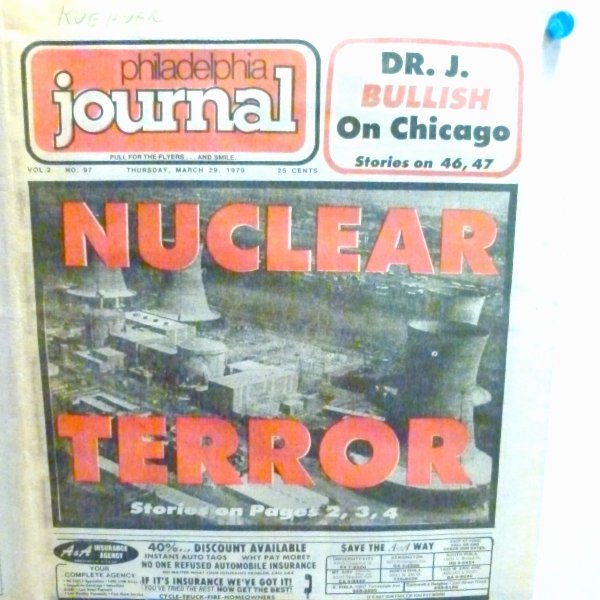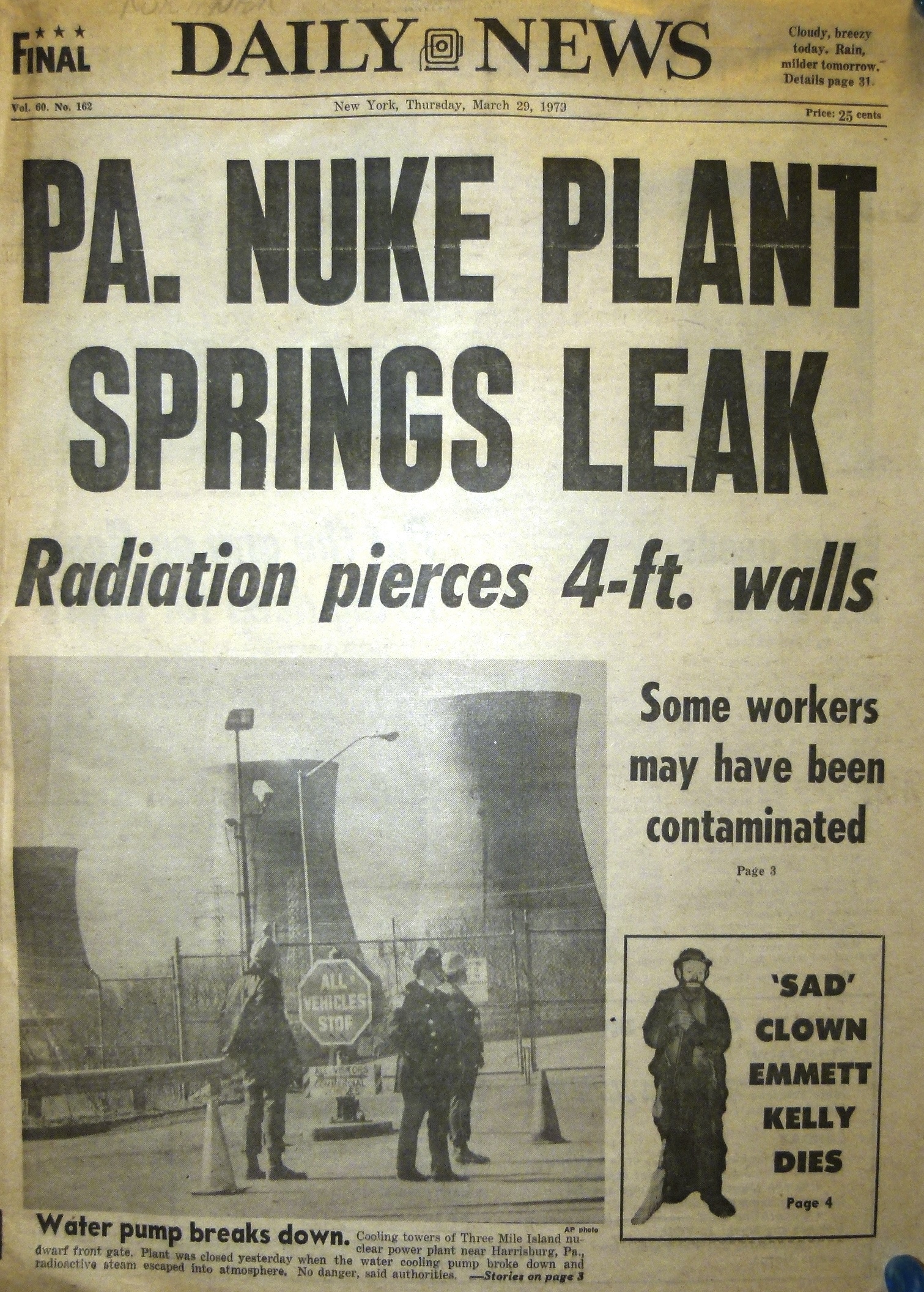The Three Mile Island, TMI Reactor accident
March 28, 1979
REFLECTIONS
OF A RESPONDER TO THE THREE MILE ISLAND ACCIDENT
TMI
about TMI, Too
Much Information about Three Mile Island
Presented at the National Radiological
Emergency Preparedness Conference
Sacramento, CA April 29, 2015
Why did I make this web page?
I was a member of the DOE Region 1
Radiological Assistance Team that responded to the accident at TMI in
1979. A friend who is still in the radiation response business thought
that the folks at the 2015, National Radiological Emergency
Preparedness Conference in Sacramento, would appreciate some of my stories and encouraged
me to pass them on. I hope that there is something to be gained from
reading the experiences of someone who responded to an actual serious reactor
accident even long after it occurred. Also, looking back, there was a lot
that was fun that happened while I was there, and I wanted to share those
experiences. And lastly, I have been retired for many years and the
meeting gave me the chance to get together with some folks who would now be
called on to respond if there was a similar problem today.
I have found that there are common elements
in emergency response of all kinds, whether as part the Red Cross, working with
people displaced by Superstorm Sandy; the local fire department, responding to
a fire or flood affecting our neighbors; or assisting police deal with a plot
by a fanatic armed with radioactive materials and explosives.

Unit 1 was down for maintenance. The
accident occurred in Unit 2. Behind it
and to the left is the auxiliary building and the vent stack that figure in the
accident.
Three Mile Island accident began about 4:00 AM on Wednesday March 28th, 1979. The plant's main feedwater pump tripped because of a problem while attempting to clear the demineralizers. With no coolant flow in the secondary loop the pressure started to rise on the primary side of the steam generator. The pilot operated relief valve (PORV) opened to relieve the pressure. These were normal, planned processes. None of this was known outside the Unit 2 control room. Like other DOE responders, I was blissfully ignorant, enjoying the last few hours of sleep I would get in the next 24.
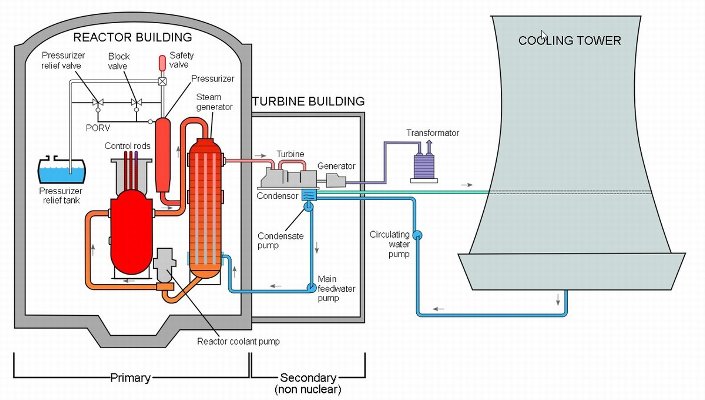
Schematic of a
Pressurized Water Reactor
The auxiliary feedwater
pumps, containment sump pump, auxiliary building, and the vent stack are
significant elements that are not shown in the diagram but come into play as
the accident progressed.
Within the first few
minutes one of the control room displays incorrectly showed that the PORV had
closed, so coolant continued to flow from the pressurizer. What that display actually showed was that power to the
solenoid controlling the valve was off. That would normally cause it to close,
but this time there was a mechanical problem causing it to stick in the open
position. The pressurizer relief tank overfilled,
burst its relief diaphragm, and primary coolant flowed to the containment sump.
From there it was pumped out of containment to the auxiliary building where the
gaseous fission products were released from the coolant to the building air and
then through the vent stack to the environment.
At this point there were
lots of alarms going off in the control room, but with no way to prioritize
them, the operators were focusing on the wrong ones.
The auxiliary feedwater
pumps started automatically but the coolant path was blocked by valves had been
closed during routine maintenance and had not been reopened when it was
completed. For the next several hours, operators continued to attempt to
control the situation but they did not prevent the core from being partially
uncovered, resulting in fuel being damaged. That
was not recognized until much later.
You now know more about the
accident than anyone did that morning.
At 6:56 AM a Site Area Emergency was
declared and Pennsylvania Emergency Management Agency (PEMA) was notified.
They in turn notified Tom Gerusky and Maggie Reilly from the Pennsylvania
Bureau of Radiation Protection (BRP), other state and local agencies and the
Governor.
Within 15 minutes reactor staff at
Metropolitan Edison (Met Ed) called the Brookhaven National Lab
Radiological
Assistance Program (BNL RAP) hotline and told one of our team captains,
Tony
Greenhouse, that they had a reading of 600 rads/hr in the auxiliary
building.
For those who aren't familiar with radiation units that is enough to be
life threatening in less than an hour. They made it clear that
they were just informing us not requesting
assistance. Tony called our department chair, Charlie Meinhold,
to let
him know what was going on.
The BRP and BNL personnel had known
each other for some time. Charlie Meinhold and Tom Gerusky had been
graduate school classmates at the University of Rochester and worked together
at BNL before Tom moved to BRP. Maggie Reilly and I were Atomic Energy
Commission (AEC) Fellows under Meinhold at BNL. Tony Greenhouse had also been
an AEC fellow at BNL a couple of years before us. Tony, Maggie, and I had
been part of 6 week long study of environmental and population radiation dose
in the Marshall Islands just one year before.
It's
Important to know your team well and a trip to the South Pacific isn't a bad
way to do it.

From
the Marshall Islands trip
Maggie and Tony
on the right and I am on the left.
At 7:24AM a General Emergency was declared. At
BNL the RAP Team members were arriving,
being briefed, and gathering equipment. Dave Schweller the head
of the
Department of Energy, Brookhaven Area Office (DOE BAO) had been told
about the
RAP call and notified DOE Headquarters at Germantown, MD of a
"substantial" problem at TMI and recommended a RAP team response.
Bob
Friess, DOE BAO, alerted the Coast Guard requesting helicopter
transport to
Harrisburg for the BNL RAP team. Bob Bores, Nuclear Regulatory
Commission
(NRC) acting duty officer at their King of Prussia office in
Pennsylvania and
another BNL alumnus we knew from when he worked there called Schweller
but did
not request RAP assistance. Again, it was a notification, not a
request
for response.
By 8:45 AM the BNL RAP team and
equipment were ready to go if requested. Schweller and Meinhold called
Pennsylvania BRP to offer our assistance. The Coast Guard helicopter
stationed on Long Island was out of service so one was in route from Cape
Cod. Meanwhile, at TMI the teams from Met Ed and BRP had found 3 mR/hr
off site and an offsite sample from a Met ED team was reported as having a high
iodine level. By 9:00 AM a call from Schweller to Bores at NRC alerted
him to the availability of the Aerial Measuring System/Nuclear Emergency Search
Team (AMS/NEST) helicopter which could serve as a part of the RAP response or
as an independent DOE resource. At Andrews Air Force Base the AMS/NEST
team was readying their helicopter and equipment so that they would be
available if needed. Their initial notification had made its way through
many people and by the time it reached them they were told the accident was at
Nine Mile Island, a nonexistent reactor, so they collected topographic maps for
both Three Mile Island and Nine Mile Point Station just to be sure.
At about 11:00 AM Bores requested
the AMS/NEST helicopter for an aerial survey of radiation levels but did not
request the BNL RAP team. A few minutes later Meinhold called Maggie at
BRP and again asked if she wanted help. Possibly concerned because of
high iodine reading on the Met Ed sample that had just been reported to them,
she said "Alright Charlie, why don't you come on down." He interpreted that
as a request to send the BNL RAP Team. By early afternoon the BNL RAP
team was loading gear and personnel onto the helicopter and more gear and
personnel into vehicles. The AMS/NEST team was doing the same at their
base at Andrews.
At this point there were two separate
DOE responses being coordinated by DOE HQ in Washington: one was the AMS/NEST
team in support of NRC and the other BNL RAP working for Pennsylvania.


The Coast Guard
SH-3 Sea King rescue helicopter
On board the helicopter were 5
flight crew, Bob Friess DOE BAO, and 7 BNL RAP health physicists (HPs).
We had radiation survey instruments, the BNL Silver Gel iodine monitor, multichannel
analyzers (MCAs), electronics, sodium iodide (NaI) detectors and every
reference manual we thought we would need for calculating doses the public
might receive. That's me standing near the nose of the helicopter in the second
picture.
A second BNL RAP team was getting
ready to follow on by van with one health physicist and 3 HP techs carrying
more radiation measuring equipment and lead shielding for our counters.
The seating arrangements in the
helicopter were utilitarian and limited. Every seat available was used
including the jump seat between the pilots where one of our HPs rode. He
had strict instructions that the controls in front of him included the throttle
and he should keep his feet off of them. The rest of us were seated along
the sides in the back with no usable windows. Because of the noise
we were all given either headsets, over which we could hear the pilots'
communications, or simply hearing protection.
The pilot told us prior to takeoff
that we had done everything we could, to overload his
helicopter and had come very close to succeeding. So he would have to get
some forward speed before it would have much lift and with the wind direction,
that meant heading straight toward the Brookhaven water tower before we
rose.
We made it -- obviously
When we were more than half way to
TMI the pilots and our man on the jump seat could see a light plane headed
generally toward us. One of the pilots got on the radio to a controller
on the ground and asked them to try to contact that plane and get it out of our
flight path. Radio communication with light planes is not guaranteed, but
he was reassured when it changed direction. Then, for some reason, that
plane turned directly toward us. According to those who could monitor
what was said, the pilot used language that was stronger than the usual reserved
tones you hear on a commercial flight. At the same time we banked and
dropped about 1000 feet. For me, not having a headset and therefore having
no idea what was going on, it was a lot like a roller coaster ride, but the
faces of those across from me who had heard the pilot went white.
As we approached TMI a warning light
alerted the pilots to a crack in one of the rotor blades. This is a
situation that requires the pilot land as soon as possible. But as he was
about to pick an interstate median or a farmer's field the light went
out. He figured it was just an instrumentation problem.
The location that the pilot had been
told was our destination in Harrisburg was a landing pad at a hospital.
It was designed for much smaller helicopters so he chose not to land there and
instead proceeded to the general aviation Harrisburg Capital City Airport about
7 miles upstream of the TMI plant.
When we were on the ground we
noticed that the AMS helicopter had also arrived but we did little more than
wave to them. After landing, our first order of business was to survey
the helicopter to determine if we had picked up any contamination on our
approach. While clambering around on the helicopter one of our team
noticed that each of the rotor blades had a small radioactive source, and there
was what appeared to be a Geiger tube on the body of the helicopter. We
asked one of the crew and he told us that each blade is hollow and pressurized
with gas, and if a crack develops the pressure bleeds off and the source moves
to an unshielded position. The blade failure light problem was
explained! We had flown close enough to the reactor for the radiation
from it to trip the warning light.
None of us had thought to have an
instrument running as we were approaching. Another lesson we learned that
day.
Wednesday evening we set up shop at
the BRP offices in Harrisburg. Most of us went out to try to find the
plume or whatever may have been deposited from it. To figure out where to
search, we used a newspaper weather map and flags that we saw as we drove
along. A couple of others of our team set up the multichannel analyzers
at BRP and started with dose assessments using measurements and samples that
had been collected by BRP and Met Ed staff. At this time the high sample
that had been taken earlier was recounted and no iodine was found.
For the field teams, radio
communication was limited to rare instances when we were close to the BRP
offices or had favorable geography. Mostly we relied on finding a pay
phone and calling in our measurements of beta and gamma, the number of air,
soil, water, and vegetation samples we had collected, and the locations of the
measurements and samples. That worked early in the evening, but many of
the phones were inside businesses which closed later that night so we were
often getting data that we were unable to report. Communication from BRP
to us would have been useful too if they had been told about a release or
change in wind direction. With what we had that night, it wasn't going to
happen.
There were occasions we asked
ourselves, "Are we lost?"
It would have been good to know the
territory, but we didn't.


Maps of the area
We
were using gas station maps similar to the ones shown here. If we were
lucky we would be sampling where all the local roads were shown like on the
first map. But often we were working in areas outside the metropolitan
Harrisburg inset map where there was a much lower level of detail so we had to
use geographic interpolation, in other words, guess. Here are a few
points on the map that may help to orient you. BRP was located in the
center of Harrisburg a couple of blocks from the river. Capital City
Airport where we landed was across the river to the south east.
Harrisburg International Airport, the area's main airport, and Middletown,
where media, NRC, and other agencies would set up their Trailer City on
Thursday, are further in the same direction but on the east side of the river.
TMI (shown on the second map) is down river a mile or two to the south east.
About midnight two of us were
driving on a back road a few miles from the plant. We had learned our
lesson from the flight and had a Geiger counter running on the seat between
us. It was making the typical background clicks. Then rather abruptly
the counts ramped up until there were so many clicks they sounded like a
hiss. That caught our attention. It didn't hurt that a couple of
minutes later a fire siren sounded. Had a major release occurred and they
were trying everything to notify the public to evacuate? It was
unrelated, but we didn't know that at the time so our imaginations ran
wild. We had found the plume. It was only a few mR/hr but it's not
what we expected after several hours of surveying and finding little or
nothing. We got out and connected the Silver Gel sampler that had been
developed at Brookhaven about a year before. This provided its first real
test.
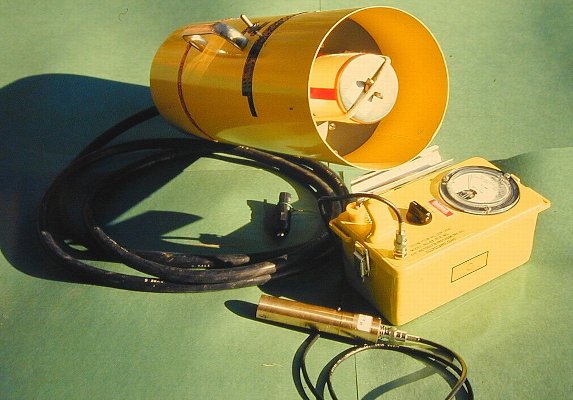
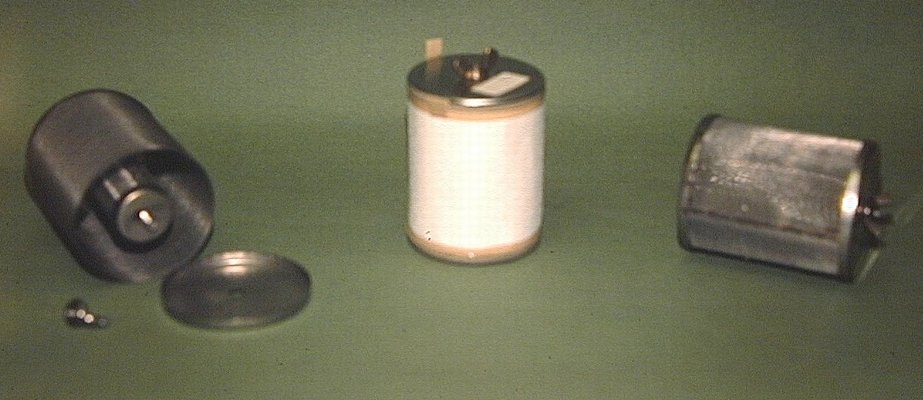
Brookhaven Silver Gel plume sampler
NUREG/CR-0314 BNL NUREG_50881
The Silver Gel sampler was designed
to capture inorganic and organic iodine by chemically binding it in silver
loaded silica gel. Noble gases had a very low absorption rate on the
gel. This means that the sampling process did a good job of
discriminating against them making it easier to measure low iodine
concentrations in a mixed plume. The discrimination was further enhanced
by a bismuth screen in the Geiger tube that enhanced its sensitivity to the
iodine with respect to the noble gas counts. It was adaptable with dual
motor windings so a simple plug would let it run on either 12V from a car or
120V line voltage. It had a preset 5 CFM flow rate so no adjustments were
needed in the field. All we had to do was sample for 5 minutes and take
the sample out of the plume, flush it with uncontaminated air, put the GM probe
into the center of the filter cartridge, take a count, peel off the filter
paper, take another count, then check background with a clean filter.
With those counts we had a fairly sensitive measure of thyroid
dose. Depending on the time after shutdown, duration of exposure, and the
age of the exposed individual, doses of a fraction of a rem to the thyroid
could be determined in the field. Our first sample did not indicate any
iodine. We also collected samples on charcoal filters as a backup.
After taking samples at a few more
locations in the plume we made our way back to the BRH offices in Harrisburg
where we counted them using a sodium iodide detector and multichannel analyzer
to enhance sensitivity as much as we could
The time was now pushing 4:00
AM. You probably have never have had the challenge of hand analysis of
such a spectra, with lousy statistics in every channel, when the result could
influence the state's decision on a major evacuation, all of this while you are
significantly sleep deprived.
Our discussion could best be
described as interesting. We then recounted what appeared to be the
highest samples for longer and looked again. We concluded that we had not
found iodine in any of the environmental samples. But based on the noble
gas on the charcoal filters we had definitely collected in the plume not just
under it. Our next priority was to find a bed.
.


AMS/NEST
helicopters
Earlier that day we had left the
AMS/NEST Andrews team at the Capital City Airport. They had started
making monitoring flights that afternoon and planning for a continuing presence
there. So they found unused offices and work spaces in one of the
hangers, had multiple phone lines installed, and set up a command center.
The first picture is the first helicopter dispatched from Andrews. The
second shows the larger one which had been on another mission and arrived later
as did still more AMS/NEST staff. A team from Bettis Atomic Power Lab
arrived from Pittsburgh. They established their base at Capital City
Airport with the Andrews group ready to sample and count.



Three members of
the BNL RAP sampling team
The second BNL RAP contingent had arrived Wednesday evening. All the teams taking measurements had the problem of distinguishing among several possibilities. Was there a plume overhead, or were they immersed in the plume, or looking at ground deposition?
On
Thursday morning this was one of the front pages that the country was greeted
with. Not exactly what was needed to reassure the public that the only
radioactive materials that had been detected outside the plant were noble gases
with very low public dose.
Radiation
piercing 4 foot thick walls and a nuke plant spewing radiation seems overly
dramatic though not as bad as the previous front page. To add to the
public's perception of what was going on, the movie, The China Syndrome had
been released just 12 days before. That movie has a line that the accident
that they were dealing with could "contaminate an area the size of
Pennsylvania." It isn't a bad movie if you can avoid getting hung up on
some errors in technical details about plant operation.

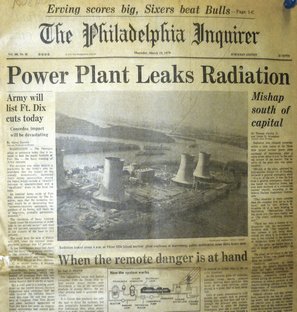
The New York Times and Philadelphia Inquirer front pages
Not
all of the reports were as outrageous. The New York Times had their story
about TMI above the fold, but other stories were given bigger headlines and
more prominent placement on the page. The Philadelphia Inquirer had a
less moderate take but not excessively scary.
As
with cable news and the internet today you need to pay attention to the
source.
On
Thursday the teams from Bettis were on scene, teams from Knolls Atomic Power
Lab in Schenectady, NY on the way, and more AMS/NEST personnel and equipment
coming from Las Vegas, Monitoring was well covered. So far noble gas but
no iodine or cesium had been detected in any of the field samples and the
off-site radiation levels were low. So I, along with the rest of BNL's
first RAP team got a chance to catch up on overdue
sleep, worked a little more, and then DOE BAO decided we weren't needed,
so we headed back to Long Island. BNL's second team left the area on
Friday morning.
Newsday article
on Saturday
On Friday I was back at BNL with
most of the rest of the first team that had been deployed, reloading our kits
with fresh Silver Gel sampling media and other supplies that had been
depleted. A reporter from the Long Island paper, Newsday, was there
with us while he was waiting for official statements from BNL and DOE BAO to be
prepared. We were not authorized to speak on the record about our
response but we took the opportunity to "teach" the reporter about Curies,
rads, reactors, and answer general questions while he was waiting for the official
news release. Our explanations seem to have been useful if you look at
his later reporting.
My recommendation is to teach
whenever you can. If you are in some emergency response field and have
the opportunity, befriend someone in the media now, so they will have you as a
trusted source for background information about some future incident or an
explanation of a technical point when they need it. Many of them will
appreciate it.
While we were talking to the
reporter and apparently in a light hearted mood we got the word that we were
going back to TMI and we got serious. This time we went by van with
counting equipment and 600 pounds of lead brick shielding for our detectors.
The reason for our abrupt turnaround and the headline, was that earlier in the
day a Met Ed helicopter flight had measured 1200 mRem over the Vent Stack
during a planned release. However, when the report of that measurement
reached Washington, the critical information about the location and timing of
the reading had been lost. Somehow it was interpreted as being at ground
level in Goldsboro, across the river from TMI.
I would offer a corollary: The
further news travels the more verification it requires. That applies equally to
its travel from place to place or through organizational levels.
There seems to be an
inverse relationship between the distance information travels and its relation
to the actual facts. Inverse Square perhaps?
Later Friday morning concern
developed in Washington that there was significant core damage and that a
hydrogen bubble had developed in the reactor that contained 1000 cubic feet of
hydrogen. One comment from an NRC Washington "expert" was that it was "A
failure mode that has never been studied. It is just unbelievable."
At the report of significant core
damage one of my coworkers asked "Could the fuel fall down into a heap at the
bottom of the vessel?"
My reply "It would be critical if it
fell into a pile", both puns intended.
Should an evacuation be ordered?
At the NRC in Washington, they were
basing their decision on the erroneous 1200 mRem reading and various officials
recommended evacuation to 10 miles downwind, or 10 miles all around, or maybe
just 5 miles. At the BRP in Harrisburg they had accurate info on that
reading and they told Governor Thornburgh that evacuation was not necessary.
NRC Commissioner Hendrie recommended
to the Governor a partial evacuation to 5 miles. President Carter told
the Governor "Err on the side of safety and caution." At his midday press
conference the Governor said "Pregnant women and preschool children within 5
miles should leave the area." The exodus began for those specified and many
others and continued through the next several days as the press continued to
report fears not facts.
A DOE contingency plan was in place
in case the situation at the reactor looked like a major release was
possible. An alternate facility had been identified at an Army
Post in
Carlisle, PA 25 miles upwind. Our instructions were to grab
essential
equipment, data, and go. With teams out collecting samples it was
necessary to have a code word that could be put out over the radio net
that was
now active courtesy of Los Vegas AMS/NEST. The code for
relocation was "Jim Thorpe." We were told it was because he grew
up in Carlisle but we knew
that it was really because he had been known as the world's greatest
athlete
and he could run.
My recommendation to those of you
who are planning for your next response "Have plans B, C, and D ready well
before you need them."
It was a dark and stormy
night. Actually it was drizzly and foggy but I can't resist the
cliche. It was after midnight and several of us were counting samples
that had been collected during the day. The routine was to count for 7
minutes, use a teletype to print out and punch paper tape for the part of the
spectra that would include the iodine peak if any, then look for any indication
of an actual peak and recount longer if we saw one, load a new sample and
repeat. We had settled down in our routine when a damsel in distress
appeared at our door.
The young lady had been dropped off
at the airport planning to pick up a Jeep that her dad had left there earlier
in the day. She intended to use it to evacuate but it wouldn't start and
she was scared. We had a few minutes between samples and she was nearly
in tears so there was no question, we were going to help if we could.
Several of us went out, opened the hood while one of us turned the key.
She and the rest of us were looking under the hood and saw a purple blue glow
appear over the engine.
She was sure it was radiation!
We recognized that moisture and the ignition wires were the problem. We
pulled them and took them inside to clean and dry them. Time to change
the sample. Reinstall the wires. There was an improvement but it
was still a long way from running well. Clean and dry the distributor
cap. Not right yet. Change the sample again.
Check the ignition wires
resistance. Some are much higher than others. Change the
sample. The high resistance was traced to the connection at the metal
tips on the wires. Once that was understood all we needed to do was
remove the tip, clip a half inch or so off the wire, and replace it.
Changing samples as needed. All the time we were doing this we were
talking to her about what we were doing and what we had found, both with the
Jeep and the environment. When the Jeep was running well we said goodbye
and sent her on her way.
We thought that was the happy ending
that we had been working toward but we were in for a surprise. About two
hours later she was back with coffee and donuts for us. I have no idea
where she had to go to get them at that hour of the night but she was now
comfortable enough with what was going on to do that for us.
Your actions can speak volumes.


Press corps at Middletown
Saturday NRC, Met Ed, and the
world's media are at Middletown, across the river and much closer to TMI than
the DOE operation.
The entire DOE operation was at the
Capital City Airport. The press didn't know about us or the scope of our
monitoring effort.

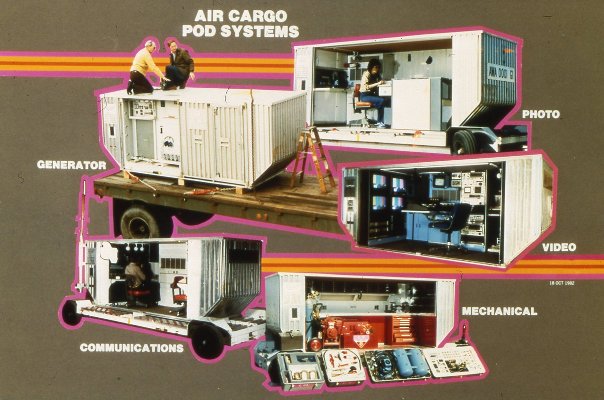
Map of the area and AMS/NEST resources


The radio net diagram and status board at the command center
By this time AMS/NEST Las Vegas was fully involved with photo and video pods on site. A radio network with repeaters had been installed; data plots, assignments, and maps were all readily available, as was data from the Atmospheric Release Advisory Center (ARAC) at Livermore. The data was provided by phone and fax until a remote terminal was delivered and set up.
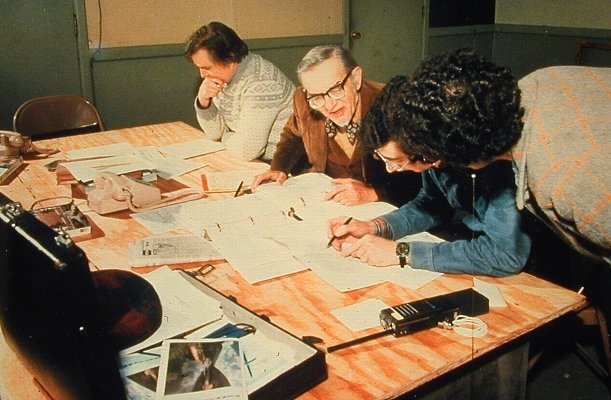
DOE dose assessment group
The DOE dose assessment group was made up of experts from throughout DOE. They were using flight and ground survey data, ARAC information, meteorology, State measurements, and TLD stations. Their work table was a piece of plywood on sawhorses, paper references were scattered about, a handheld radio and phone for communication, and not a computer anywhere to be seen. By this time the analyzed output was going to State, NRC, and Met Ed.

ARAC plot with
annotations
Here is an ARAC plot updated
with some of their notations. Something that strikes me when looking at
this plot is that the world is lumpy. You can't possibly get enough data
to model all of that lumpiness. When pressed, the folks responsible for
those models admitted there isn't a good reason to expect that any particular
bubble that is shown on this map is actually where the model predicted. However,
the maps do provide a good estimate of the scale and magnitude of the
variations to be expected.

Dose assessment
output
This is one example of the many dose
assessments they produced
About 3:00 AM Sunday morning a call
came in to the command center. It was down the hall from where I was
working and it kept ringing. Since I was about the only person available
at that hour I answered it
It was from the Whitehouse!
A staffer was preparing a briefing
for President Carter prior to his visit scheduled for later that day. I
didn't have the answers needed so I called Andy Hull who by many, was
considered to have the best grasp of the total dose picture. He had the
current information that was required and could interpret it for them.
My takeaway from that was "If
you don't know, admit it, and find someone who does."
My usual jobs for the remainder of
the response were to collect representative samples starting in the afternoon
then package and count them, looking for any iodine, continuing late into the
night. Then prepare a report of what was found for the dose assessment
group. It should be noted that nonstandard samples may be useful. A
sample from a puddle or a ditch by a road may increase detection sensitivity
because it has collected from a large area and so can be useful even though you
won't be able to use it to compute a population dose. They can be used to
confirm that something more than noble gases is getting out of the plant.
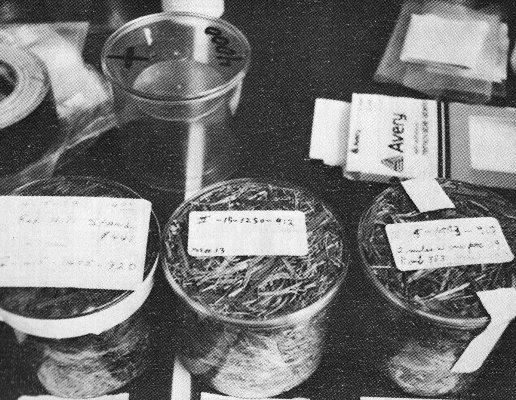
Some
environmental samples
Here are some of our vegetation
samples in Marinelli beakers labeled and ready for counting.

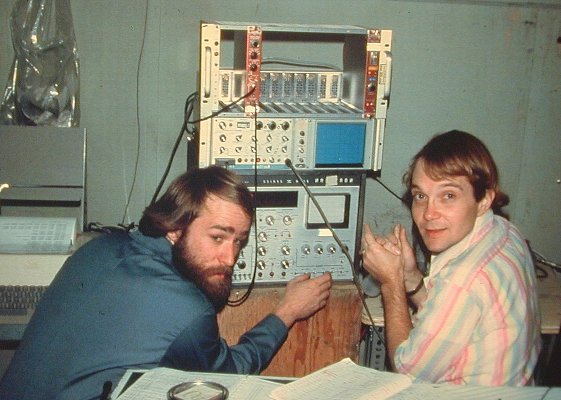

Sample counting facilities
Our
work area was similar to what the dose assessors were using, with our analyzers and teletypes on work benches made
from boards and 55 gallon drums or packing crates with teletypes for readout.
That's me in the third picture.
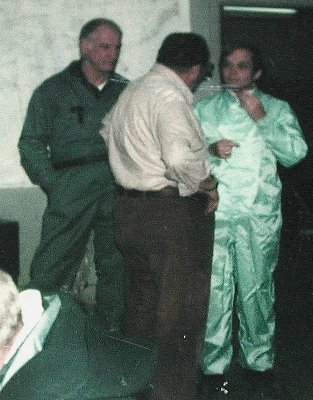
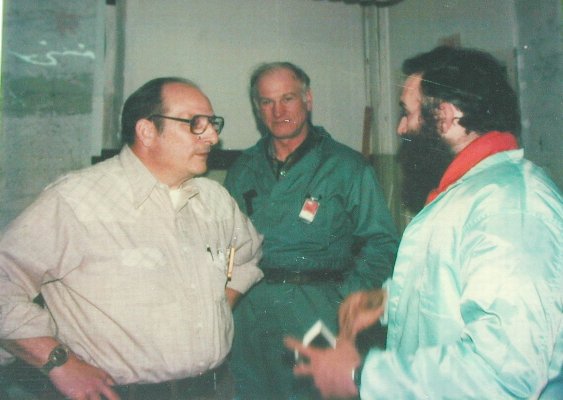
Our
usual attire when collecting samples didn't let us travel unnoticed. It
was effective in keeping us warm, reasonably dry, and clean but it tended to
attract attention when we were out. On one sample collecting foray, I
made a quick stop at my motel to pick up something. As I was jogging back to the car a small
group of people saw me and were sure I was running because of radiation. Seeing
their reaction I stopped to explain that I was one of a team that had been
there to measure radiation since the first day of the accident, and that we
hadn't found anything to be alarmed about. I also explained that I was
rushing because I was late not for any other reason.
Keep in mind that whatever you are doing your actions can be misinterpreted.
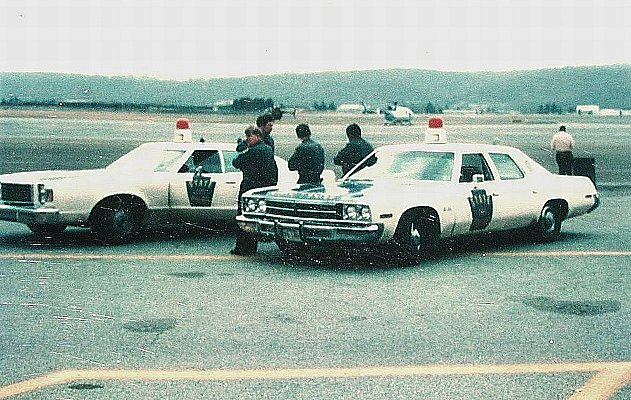
State police provided transportation
The
Pennsylvania State Police training barracks is located in Hershey not far from
TMI so officers were pressed into service as drivers for sample
collection. This had a couple of advantages. First, they knew the
roads so we didn't have to figure out where we were, and second, we could be
labeling samples and writing our logs while we were getting to the next
location, saving some time. Each sampling team would be given roads to
cover. Every half mile we would collect vegetation and soil samples, take
gamma and beta readings, and grab water samples whenever we passed a stream or
pond. While I was doing this my driver noticed that we had someone
tailing us. He would stop when we did, and observe what we were
doing. Obviously a reporter, but this time I wasn't inclined to be
helpful.
The officer asked "Do you want to lose him?"
My
reply, "YES!"
And we were off on a ride that rivaled the one in the helicopter. You probably already know that you should be careful what you say to an officer.

Brookhaven
continuous air sampler
One
day my assignment included air sampling. This time I was using another
BNL developed sampler, pictured here. It was intended to sample at a
lower rate for a longer time. It required 120 V power so several had been
set up at fire and police departments, churches, schools, and other public
facilities. For those I just needed to verify the flow rate, change the
sample cartridge and record the time. There was one site directly across the
river from the plant, south of Goldsboro. We would sample it occasionally
and whenever we had been alerted to a planned release. Because it wasn't
near any public source of power, we would set up a small generator, plug it in
and let it run as required. When I was setting up I noticed two farmers
watching from a porch a few hundred feet away, so I went over to talk to them
while it ran. In the course of our discussion I asked them if they
weren't concerned since they were so close to the reactor. One of them
replied that based on what I was doing he figured that I probably knew if it
was dangerous to be there, and I hadn't left so they didn't see any reason to
either.
Again, what you do can be far more important than what you say.

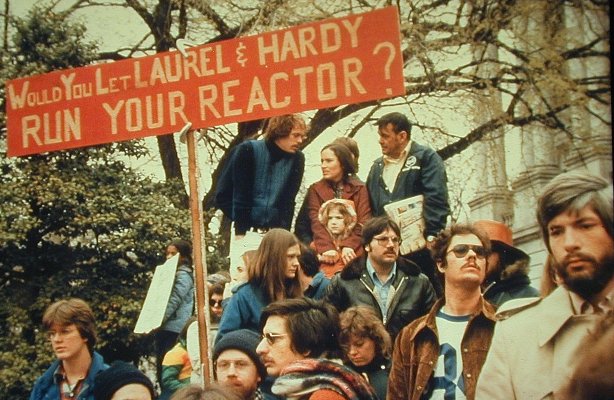
Harrisburg protests
These pictures, taken at a protest in Harrisburg, will give you a sense of the local reaction. And in Washington outside the church President Carter attended was a sign "Stop the merchants of Atomic Death." Fortunately I was spared any direct contact with these folks.

Iodine
and noble gas pathway to the environment
You may be wondering where the iodine went. With failed fuel you would expect it to be released. This diagram shows the principal parts of the path from the core to the environment. From the fuel elements in the reactor some of the iodine went to the coolant and from there through the PORV (here called the safety valve). The tank intended to catch the coolant overflowed onto the containment floor. From there some of the coolant was pumped into the auxiliary building. Some of the gases that had been dissolved in the coolant exchanged with the building air and went up the vent stack.
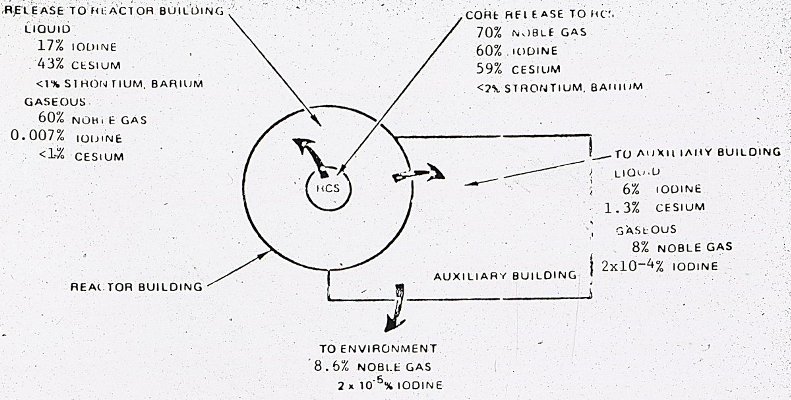
Core inventory
to environment fractions
This diagram is based on a very much later analysis. It shows the percentage of the inventory
of radioactive materials in the core
that made it
through each of these steps from fuel to the environment. The table
below
summarizes the fractions. It is apparent that the tendency of
iodine to remain dissolved in the water released from the reactor
vessel prevented a much larger environmental release. This
resulted in much lower public dose than had been assumed prior to that
time.
|
|
Strontium, Barium |
Cesium |
Iodine |
Fraction of the iodine released from the liquid |
Noble gases |
|
Core to reactor coolant |
< 2 |
59 |
60 |
|
70 |
|
To containment building in the liquid |
< 1 |
43 |
17 |
|
|
|
To containment building as a gas |
|
< 1 |
0.007 |
4x10-4 |
60 |
|
To auxiliary building in liquid phase |
|
1.3 |
6 |
|
|
|
To auxiliary building as a gas |
|
|
2x10-4 |
7x10-5 |
8 |
|
To the environment as a gas |
|
|
2x10-5 |
|
8.6 |
Percent of core
inventory released to various compartments
Walter
Cronkite at the time was known as the most trusted man in America. His
comments over the first three days of the accident: On Wednesday "The
start of a nuclear nightmare." Thursday "There's more heat than light in
the confusion surrounding the incident." I certainly agree with that
one. On Friday he talked about Prometheus, Frankenstein, and "Tampering
with natural forces."
He
wasn't helping to calm the public's concern.
Newsweek, Time and more news articles can be found at this link.
Here is a quick summary of things I
learned or found useful during my response to TMI:
Know your team well.
Don't be reluctant to ask for
help.
Prepare for contingencies.
Have plans B, C, and D ready before they are needed.
Know where you are going both
geographically and logically.
Know and trust your instruments and
the resources you have available.
The media can be your friend, or
not.
Teach whenever you can.
The further information travels
through the organization the more verification is required.
Your actions can be much more
important than your words.
Recognize that you can't get enough
data to completely model the world.
Politics trumps science every
time.
Have staff available to run 24/7 for
as long as required.
If you don't know something, admit
it, and find someone who does.
You may be the only one who knows
some fact, share it.
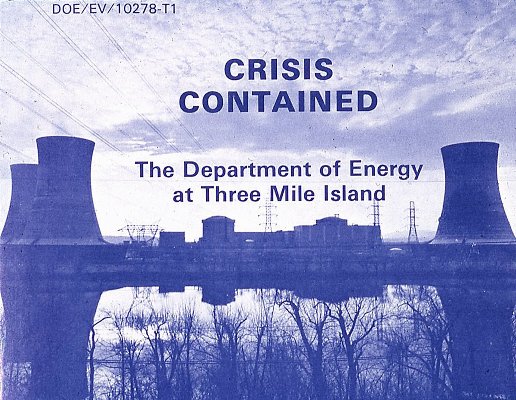
The time line and some of the quotes are from "Crisis Contained, The Department of Energy at Three Mile Island, A History, December 1980"
A couple of things you may find useful as training aids when explaining radiation effect to members of the general public.
For a good
graphic showing the relative size of radiation doses and their effects: https://xkcd.com/radiation/
Go to our Science Fun page
Go to our Travels page
Go to our Personal home page
Go to our Community page
E-mail Nancy and Alan
Science Fun, Inc. is a 501(c)(3) nonprofit corporation.
If you would like to help us here in Eastern Kentucky please send a note to us or click on the button below and select an amount.
